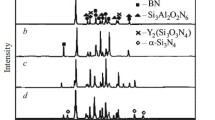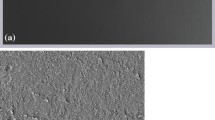A composite material based on the B4C–SiC system with different initial carbon contents was obtained by reaction sintering (impregnation of a porous billet with liquid silicon). Carbon reacted with silicon to form a secondary silicon carbide that filled the space in the porous workpiece until a monolithic material was obtained. Boron carbide acted as the source of carbon if it was initially absent or its content was low. The obtained materials had the following characteristics: bending strength up to 320 MPa, density up to 2.85 g/cm3, microhardness up to 30 GPa.



Similar content being viewed by others
References
T. Abraham, “Powder market update: Nanoceramic applications emerge,” Am. Ceram. Soc. Bull., 83(8), 23 – 25 (2004).
F. L. Matthews and R. D. Rawlings, Composite Materials: Engineering and Science, CRC Press, Boca Raton, Fla., 2003 [Russian translation, Tekhnosfera, Moscow, 2004, 408 pp].
D. Sciti, A. Balbo, C. Melandri, et al., “Microstructure and properties of an electroconductive SiC-based composite,” J. Mater. Sci., 42(14), 5570 – 5575 (2007).
D. D. Nesmelov and S. N. Perevislov, “Reaction sintered materials based on boron carbide and silicon carbide,” Glass Ceram., 71(9 – 10), 313 – 319 (2015).
S. N. Perevislov, P. V. Shcherbak, and M. V. Tomkovich, “High density boron carbide ceramics,” Refract. Ind. Ceram., 59(1), 32 – 36 (2018).
S. N. Perevislov, P. V. Shcherbak, and M. V. Tomkovich, “Phase composition and microstructure of reaction-bonded boron-carbide materials,” Refract. Ind. Ceram., 59(2), 179 – 183 (2018).
M. A. Markov, A. V. Krasikov, P. A. Kuznetsov, A. D. Bykova, M. V. Khromenkov, and E. A. Samodelkin, “Method of producing ceramic structural material based on silicon carbide for articles of complex geometry,” RU Pat. 2,739,774, C04B35/573, Dec. 28, 2020; Byull., No. 1.
N. P. Bansal (ed.), Handbook of Ceramic Composites, Kluwer Academic Publishers, 2005, 554 pp.
Z. Yang, X. He, M. Wu, et al., “Infiltration mechanism of diamond/ SiC composites fabricated by Si-vapor vacuum reactive infiltration process,” J. Eur. Ceram. Soc., 33(4), 869 – 878 (2013).
S. Hayun, A. Weizmann, M. P. Dariel, et al., “Microstructural evolution during the infiltration of boron carbide with molten silicon,” J. Eur. Ceram. Soc., 30(4), 1007 – 1014 (2010).
M. P. Dariel and N. Frage, “Reaction bonded boron carbide: Recent developments,” Adv. Appl. Ceram., 111(5 – 6), 301 – 310 (2012).
T. Ya. Kosolapova, T. V. Andreeva, T. S. Barnitskaya, et al., Nonmetallic Refractory Compounds [in Russian], Metallurgiya, Moscow, 1985, 224 pp.
G. V. Samsonov, T. I. Serebryakova, and V. A. Neronov, Borides [in Russian], Atomizdat, Moscow, 1975, 375 pp.
S. N. Perevislov, A. S. Lysenkov, D. D. Titov, et al., “Liquid-sintered SiC based materials with additive low oxide oxides,” IOP Conference Series: Materials Science and Engineering, IOP Publishing, 2019, 525(1), Art. 012073.
S. N. Perevislov,M. A. Markov, A. V. Krasikov, et al., “Effect of SiC dispersed composition on physical and mechanical properties of reaction-sintered silicon carbide,” Refract. Ind. Ceram., 61(2), 211 – 215 (2020); Nov. Ogneupory, No. 4, 41 – 45 (2020).
S. N. Perevislov, M. V. Tomkovich, M. A. Markov, et al., “The influence of dispersed composition of SiC on the physico-mechanical properties of reactive-sintered silicon carbide,” J. Mach. Manuf. Reliab., 49(6), 511 – 517 (2020).
S. N. Perevislov, A. S. Lysenkov, D. D. Titov, et al., “Materials based on boron carbide obtained by reaction sintering,” IOP Conference Series: Materials Science and Engineering, IOP Publishing, 2019, 525(1), Art. 012074.
M. A. Markov, S. S. Ordan’yan, S. V. Vikhman, et al., “Preparation of MoSi2–SiC–ZrB2 structural ceramics by free sintering, Refract. Ind. Ceram., 60(4), 385 – 388 (2019).
Author information
Authors and Affiliations
Corresponding author
Additional information
Translated from Novye Ogneupory, No. 2, pp. 29 – 33, February, 2023
Rights and permissions
Springer Nature or its licensor (e.g. a society or other partner) holds exclusive rights to this article under a publishing agreement with the author(s) or other rightsholder(s); author self-archiving of the accepted manuscript version of this article is solely governed by the terms of such publishing agreement and applicable law.
About this article
Cite this article
Belyakov, A.N., Markov, M.A., Perevislov, S.N. et al. Investigation of the Structure and Physicomechanical Characteristics of Reaction-Sintered Materials B4C–SiC. Refract Ind Ceram 64, 67–70 (2023). https://doi.org/10.1007/s11148-023-00806-0
Received:
Published:
Issue Date:
DOI: https://doi.org/10.1007/s11148-023-00806-0




